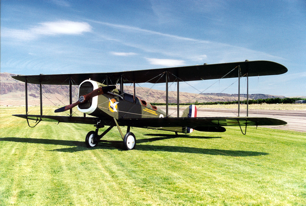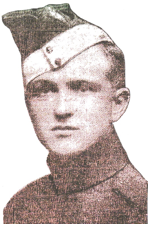Thomas Archibald Dickinson (1896 – 1931)

Youngstown Vindicator – November 5, 1931
Dickinson, War Flyer, S-T
Engineer, Is Found Suicide
__________________________________
Body Discovered Near Poland Mayor’s
Home – Father of Many Inventions
__________________________________
Thomas Archibald “Arch” Dickinson, age 35, Poland, efficiency engineer of the Youngstown Sheet and Tube Co. and a wartime aviator, committed suicide by shooting himself through the head. His body was found today along a creek in the rear of the estate of W.L. Countryman, Poland mayor, after an all-night hunt by Poland residents.
Dickinson had been missing since he voted at the village precinct Tuesday afternoon. Mrs. Dickinson, however, did not report him missing until last evening, when a search was begun. The body was found at 9:30 a.m. today.
Calling Clark Wagner, Poland marshal, Mrs. Dickinson told of husband’s disappearance. She said that he had left home, taking his gun with him and expressed fear that he might have taken his life, Wagner said today.
Dickinson was of a nervous temperament, high strung, and had been near a nervous breakdown when he returned from the war, due to his experiences in air fighting. “He had been worrying terribly of late.” Wagner quoted Mrs. Dickinson as saying.
Organizing 12 men, Wagner started out to search for Dickinson early this morning. The party first searched around the schoolhouse and then circled the Countryman place. After a half hour search in that locality one of the posse saw Dickinson’s body in the shallow creek. He had evidently walked to the middle of the stream and fired the shot through his head. The body was face downward, the revolver clutched in his right hand. Dickinson’s watch had stopped at 9:25.
Was War Hero
Dickinson had a promising career of great value. He had an outstanding World War record, winning the Distinguished Service Cross and the Croix de Guerre. He was born Oct. 8, 1896 in England, the son of Mr. and Mrs. Thomas Dickinson and came to the United States in September, 1901.
Early in 1915, Dickinson then only 18 years old, went to Canada and joined a Canadian unit of the British Royal Flying Corps. After months of training in Canada, he was sent to the front in France and was assigned to flying two-place observation and bombing machines, said to be the most dangerous type of war flying, since the machines were cumbersome and slow, half as speedy as the fast German scout planes.

“The Flying Coffin”
deHavilland DH4
Dickinson, with an observer, frequently was sent out to bomb enemy railroad stations and munitions depots. Each raid meant a fight with speedy German scouts, with little hope of getting home. Records show that Dickinson shot down a number of enemy planes but he dismissed each victory with a scant note in his log book. He even failed to show up to get his decorations.

Lt. T. A. Dickinson
Won Unusual Fight
Second Lieutenant Dickinson and his observer, Second Lieut. Norman Frederick Frome, won the D.S.C. in an unusual fight behind the German lines. Dickinson and Frome, both inexperienced in air fighting at that time, were sent out with a deHavilland biplane – a plane dubbed by war flyers as “the flying coffin” – to bomb several German bridges. Flying dangerously low, they bombed the bridges and then attacked a large force of enemy troops. Four fast German Fokkers jumped on the slow British plane but Dickinson and Frome drove off the planes and resumed “strafing” the ground troops. Two machine guns opened up on the plane and, diving on the nests, Frome quickly silenced both guns, but not until their plane was badly shot up and the gas tank was being quickly emptied. Dickinson sped over the lines as his motor quit and landed just back of the lines. Dickinson and Frome counted 53 holes in their machine. Dickinson had numerous narrow escapes, once when he was wounded and another time when a bullet tore through the overseas cap he was wearing in the air. He kept the cap as a souvenir. He had a number of bad crashes, when his machines were crippled in fights.
Mrs. Dickinson said that her husband had always been nervous and high strung, and that at times he appeared to be overcome by conditioned resulting from the depression. It is believed that this condition of nervousness may have been brought about because of his service during the war.
Works for S. & T.
Shortly after the war closed, Dickinson returned to the United States and was first employed by the Sheet & Tube Dec. 5, 1919, working in the seam engineering department as testing engineer. Later Dickinson was made chief engineer in the efficiency department.
Since being at the Sheet & Tube, Mr. Dickinson has shown inventive ingenuity. He once invent a means of preventing the theft of electric light bulbs, and the method was extensively used in the local plant. He was also the inventor of several efficient rates and standards, Sheet & Tube officials said. Other inventions include a fountain pen, a steam meter, and an automobile hub lock. Back in 1922 he devised a radio that could be made for 40 cents.
Dickinson was well known throughout the city and was active in community affairs in Poland. He was a member of Western Star Lodge, F. & A. M. No.21. Mr. and Mrs. Dickinson were married in England just after the close of the war; she being Miss Eleanor Violet Binfield, whom he met while she was singing for soldiers in an English camp. They had one son, Paul, aged nine.
Editor’s Comments:
Thus ends the front page news item 75 years ago. Further research into the untimely death of one of Poland’s distinguished citizens reveals the follow facts. Mr. and Mrs. Dickinson bought a house at 15 College St. in Poland, Ohio, under land contract and in 1927 receive the deed to this two story bungalow. After her husband’s death, Eleanor Dickinson moved to Los Angeles and the house was sold to Mr. Countryman in 1933.
A check of the military records at the Mahoning County Courthouse shows that T.A. Dickinson, a Canadian Veteran, was buried in Poland’s Riverside Cemetery in Lot 846. This lot was donated by the cemetery for use by the American Legion. Lot 846 now contains the body of another war veteran. A single notation on the cemetery record cards states, “Stone of T.A. Dickinson, no body in cemetery.” I will continue to search for his burial site and keep you posted.
(Youngstown Vindicator, November 6, 1931)
“Arch” Dickinson’s Rites to Be
Burial from Plane in Sky
From an airplane high over Poland and Mahoning County the ashes of the earthly remains of T. A. “Arch” Dickinson, aged 35, will be spread to the winds to rest on the countryside he has loved so well for the last 12 years. This unusual service had been Mr. Dickinson’s wish since he emerged from a brilliant service in the World War and carrying scars of many battles in the air.
Masonic funeral services will be held at 10 A.M. tomorrow in the Presbyterian Church at Poland with Rev. Frank O. Leonard preaching the eulogy. Later the body will be taken to Cleveland for cremation and within a few days a tiny urn will be placed aboard an airplane for the final flight back to Poland for the interment to the winds. As the plane circles overhead, Poland citizens will bow their heads in meditation, for “Arch” Dickinson’s tragic death has saddened the entire community.
Of a retiring nature and modest temperament, few persons outside his family knew Mr. Dickinson, knew him intimately, but everyone loved him. His refusal to talk of his war career showed his extreme modesty, but a Distinguished Service Cross, Croix de Guerre and Distinguished Flying Cross told their own story. The Prince of Wales, while on a visit to this county, was to have presented the latter award to Mr. Dickinson, but his dislike of publicity was given as his reason for not going to New York to receive the cross, and it was sent only mail.
Attorney Franklin B. Powers, at the Exchange Club meeting yesterday touched on Mr. Dickinson’s career. Attorney Powers is a resident of Poland. The pallbearers at the funeral tomorrow will be members of the Poland Post, American Legion, including: T.C. Watts, Clifford Smith, Charles Johnston, Frank McCoy, Dan McCullough, and Harrison Sexton.
Editor’s Comments:
Once in a while a historian will get lucky and find information not available from normal sources. After checking the military records of “Arch” Dickinson, pouring through the cemetery cards, calling funeral homes, and inquiring at the Mahoning Valley Historical Society, it became apparent there was no record of where his body was laid to rest. Then on a hunch, I went back to the Youngstown Vindicator to see if anything more had been written following the suicide article on November 5th. The above article and photograph were found in the following issue of the newspaper and explains why Mr. Dickinson’s grave could never be found. This article also tells of a relatively new procedure 75 years ago call “cremation.” The fact that his body was sent to Cleveland indicates that cremation was not being widely used here in the Mahoning Valley in 1931.
During the search I learned that only four Distinguished Service Crosses were presented to flyers during the fighting in France and Lt. Dickinson had received one of them. It is also interesting to note that Mr. Frank McCoy, a pallbearer, was later buried in the same grave that had been set aside by Post 145 of the American Legion for “Arch” Dickinson 14 years earlier. Today Attorney Powers and several other pallbearers are also buried in the Riverside Cemetery. Sadly, there is no marble monument to our WW I flying hero. Perhaps Lieutenant Thomas Archibald Dickinson wanted it that way.
